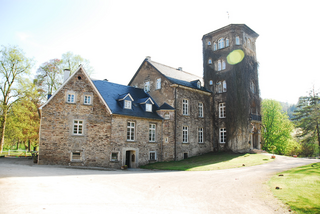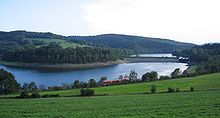
The Sauerland is a rural, hilly area spreading across most of the south-eastern part of North Rhine-Westphalia, in parts heavily forested and, apart from the major valleys, sparsely inhabited.

Wenden is a municipality in North Rhine-Westphalia, Germany. It belongs to the Olpe district in the Sauerland. It lies 10 kilometres south of Olpe and 20 km (12 mi) northwest of Siegen.

Siegen is a city in Germany, in the south Westphalian part of North Rhine-Westphalia.

The Möhne Reservoir, or Moehne Reservoir, is an artificial lake in North Rhine-Westphalia, some 45 km east of Dortmund, Germany. The lake is formed by the damming of two rivers, Möhne and Heve, and with its four basins stores as much as 135 million cubic metres of water.

Schmallenberg is a town and a climatic health resort in the High Sauerland District, Germany. By area, it is the third biggest of all cities and towns of the state of North Rhine-Westphalia and the second biggest of the region of Westphalia.

Attendorn is a German town in the Olpe district in North Rhine-Westphalia. As of 2019 it had a population of 24,264.

Lennestadt lies in the Sauerland in southeast North Rhine-Westphalia and is a community in Olpe district. It is the district's most populous municipality. Lennestadt itself is not an actual town but a community which comprises several towns and villages.

Olpe is a town situated in the foothills of the Ebbegebirge in North Rhine-Westphalia, roughly 60 km east of Cologne and 20 km northwest of Siegen. It is part of the Regierungsbezirk of Arnsberg and is the seat of the district of Olpe.

Finnentrop is a Gemeinde (municipality) in Olpe district in North Rhine-Westphalia, Germany.

Kirchhundem is a German community in North Rhine-Westphalia. It belongs to the Olpe district.

Kreuztal is a town in the Siegen-Wittgenstein district, in North Rhine-Westphalia, Germany.

Netphen is a town in the Siegen-Wittgenstein district, in North Rhine-Westphalia, Germany. It lies on the river Sieg, roughly 7 km northeast of Siegen.

The Hengsteysee is a reservoir on the Ruhr river between the cities of Hagen, Dortmund and Herdecke, North Rhine-Westphalia, Germany. It was built in 1929 and is one of five reservoirs on the Ruhr.

Wendener Hütte is a retired Industrial Age ironworks and hammer mill located near Wenden, Germany. The complete site, supported and run by Museumsverein Wendener Hütte e.V., is open to visitors from April to October.

Burbach is a municipality in the Siegen-Wittgenstein district, in North Rhine-Westphalia, Germany.

The Sorpe Dam is a dam on the Sorpe river, near the small town of Sundern in the district of Hochsauerland in North Rhine-Westphalia, Germany.

The Lenne Mountains, or Lenne Uplands (Lennebergland), is a range of hills up to 656 m above sea level (NN) high in the German state of North Rhine-Westphalia. It is part of the Süder Uplands within the Rhine Massif.

The Ruhr–Sieg railway is a 106 km long double-track, electrified main line from Hagen to Siegen via Iserlohn-Letmathe, Finnentrop and Kreuztal in the German state of North Rhine-Westphalia. The line, which has many tunnels, runs primarily through the valley of the Lenne. South of Altenhundem it crosses the watershed between the Lenne and the Sieg. The line was opened between 1859 and 1861 and is one of the oldest railways in Germany.

The Ruhr-Lenne-Express is a Regional-Express service in the German state of North Rhine-Westphalia, running from Essen via Bochum, Witten, Bochum, Hagen and Iserlohn-Letmathe to Iserlohn. It is operated by VIAS Rail hourly.

The Kreuztal–Cölbe railway is a 88-kilometre-long main line in Hesse and North Rhine-Westphalia, Germany. It branches off the Ruhr–Sieg railway at Kreuztal and runs via Erndtebrück, Bad Laasphe and Biedenkopf to Cölbe. Operationally, the line is now divided into two parts. The Kreuztal–Erndtebrück section is operated together with the Erndtebrück–Bad Berleburg railway as the Rothaar-Bahn and the subsequent section to Cölbe, now operated by the Kurhessenbahn, is called the Obere Lahntalbahn. Trains at the eastern end of the line run to/from Marburg (Lahn).





















